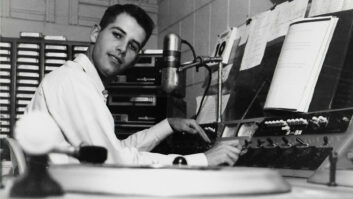
Earl Reilly worked in radio and TV in the Pacific Northwest for 60 years, with job titles like GM, broker and ad rep. But techies will recognize kin:
“My life in broadcasting began while I was living at our family home in Everett, Wash.,” Reilly writes on page 1 of his humor book “According to Earl.”

“I became interested in technical radio. In those days to develop personal radio equipment you wound your own coils, assembled parts and build everything from scratch according to a circuit diagram. I obtained some condensers and resistors (they were called grid leaks then) from old, discarded Atwater Kent battery radios.
“My first one-tube radio was powered by Burgess dry cell batteries. I strung a copper wire from my bedroom to a neighbor’s tree. With my earphones I was able to hear shortwave stations from all over the world. It was a thrill to hear Big Ben strike on the hour from London’s BBC Radio.”
Reilly proceeds to offer us “untold humorous stories and bloopers from early radio and TV” including anecdotes about building an amateur radio rig in a tiny room at the YMCA; his brief stint as chief engineer at KRKO; his air persona as “Spike Hogan” at KXA; his decision to take a sales job at KING in 1952; his move into television and the rep biz.
Autobiographical books like Reilly’s show up often at Radio World. I enjoy telling you about them.
Please understand something: These aren’t likely to be Pulitzer Prize winners. They won’t bolt you into your sofa for weeks as a great David McCullough or Laura Hillenbrand story would. They don’t arrive gorgeously bound. The spacing of text might be streeeeeetched just to fill space; the editing might be iffy. Some look amateurish.
I say all this because I want you to know what you’re getting if you buy some of the books I mention. But if you love to sit around and “talk radio,” such books will appeal regardless. You probably don’t care whether they are thick or pretty. Their stories offer us a slice of what radio looks like, or looked like, through the eyes of peers. They let us “sit down with a colleague” and pass pleasant time.

Eunice Randall, Boston’s first female announcer, is shown in 1921 at the AMRAD studio. Courtesy Arcadia Publishing/Eunice Stolecki
Reilly’s is a good example. It consists of only 100 pages of spacious text; you can hand the book to another radio history lover after you’ve zipped through it in one sitting. And it would be a pleasant sitting, given Reilly’s technical chops and fearlessness about looking silly. (The three dozen photos include a few doozies including “the infamous office rock” and one of Earl with George the dead elk.)
“According to Earl” is an unpretentious piece of personal broadcast history, a lightweight paperback from a guy who doesn’t take himself too seriously. Find it at the NAB Store or online retailers like Amazon and Barnes & Noble. Retail: $12.95.
* * *
Not a personal recounting, but reflective of a personal love affair, is Donna Halper’s book on Boston radio.
It isn’t much thicker than Reilly’s but is jammed, front to back, with fabulous photos. I mentioned it on RW’s blog and share it here.
The “Images of America” series from Arcadia Publishing explore aspects of local U.S. history through great archival photos. I wrote in 2008, “If Arcadia knows what’s good for it, the company would launch a full series of radio station history books in the mold of this WLS title. They’d have a hit.”
Maybe the publisher was listening, I don’t know; but here comes Halper, who takes readers from Boston radio’s formative years and the ensuing Golden Age, right up to the “Internet age.” There are pix and stories about WBZ, the Yankee News Service, Arnie Ginsburg (that’s “Woo Woo” on the cover), Curt Gowdy and pioneering 1XE, later WGI, the “AMRAD” station. And more.
The book of black-and-white photos retails for $21.99; you can find out more about it and search for other radio titles at www.arcadiapublishing.com.

* * *
Briefly, a few other notables:
“The New DXer’s Handbook” — Here’s a free PDF about the basics of successful DXing. Download it at dx-code.org/newdxer.pdf. Material is by Bryce K. Anderson, K7UA, based on work for the membership of the Utah DX Association, of which he was president.
“Radio Survives and Thrives” — Described as a history of Kentucky broadcasting from 1945–1970, this isn’t really a book, it’s more a chapter, and a short one, at that. In fact author Kenneth D. MacHarg originally wrote the material for use in a larger work. He penned it in 1996 and wanted to disseminate it now for folks interested in the Kentucky subject matter. This is very short; you will wish for more, given the promise of the title. It lists for $8.99 and can be purchased at www.createspace.com, or $4.99 in Kindle edition at Amazon.
“Public Radio Resource Guide” — The Public Radio Satellite System recently updated an online handbook that provides resources for public stations, producers and vendors. PRSS promises this is “more robust than a previous print version.” The organization used to publish a “Producers Resource Guide” but stopped eight years ago. Find the guide to technology, training, resources, funding and conferences at www.prss.org.
“Vox Populi” — Seven hundred pages of Bill O’Shaughnessy: his radio interviews, podium remarks, tributes to fallen friends and print editorials. The Whitney Radio owner is known as a First Amendment defender; he’s also a raconteur, a backslapping affable guy. This is his fourth collection and it’s perfect for reading for 10 minutes each night. You won’t be disappointed when this $35 hardback lands heavily on your desk. (And of course there’s lots of Mario Cuomo.) Published by Fordham University Press.












